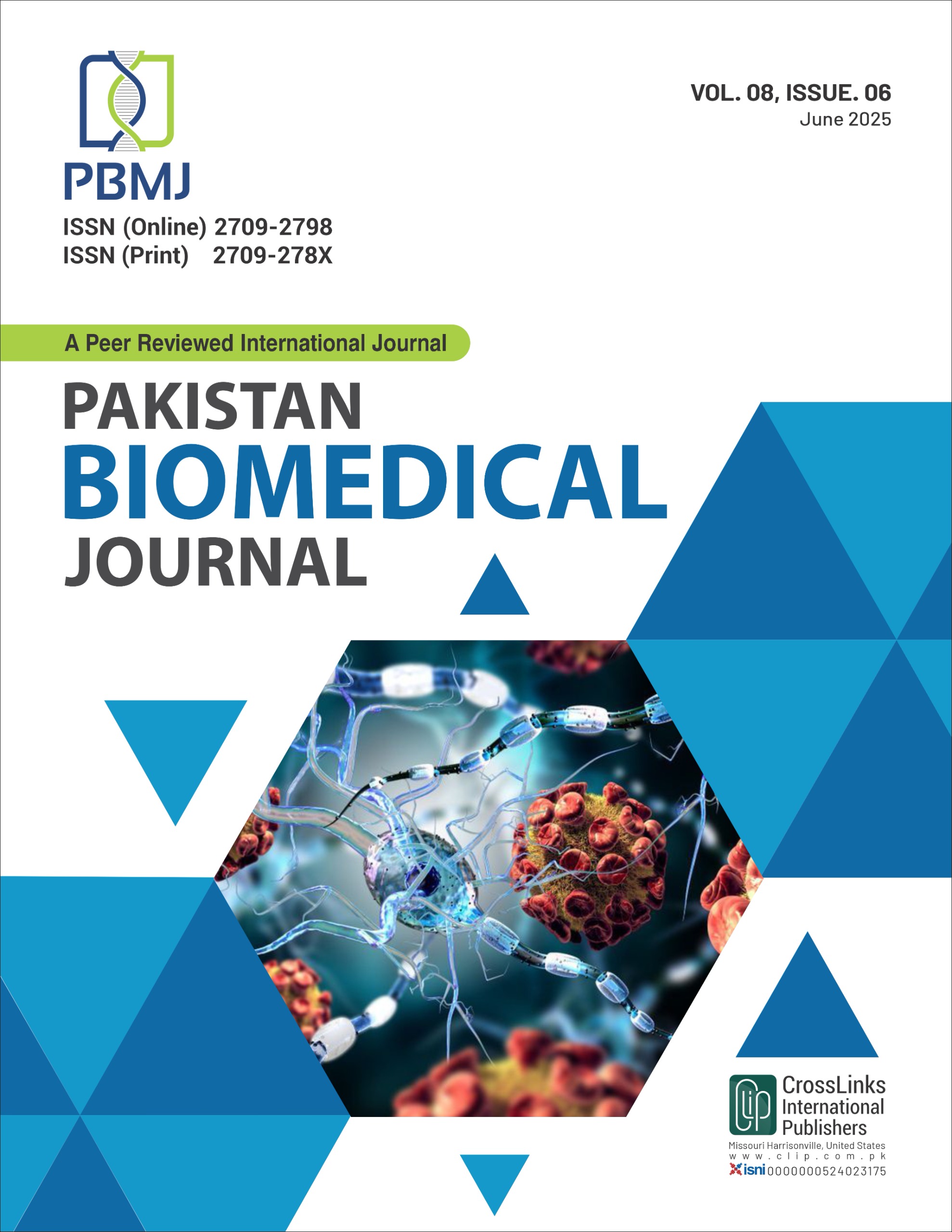Pulmonary Tuberculosis Rehabilitation: Evidence-Based Physiotherapy and Technological Advancements for Sustainable Development Goal Achievement, a Narrative Review
Pulmonary Tuberculosis Rehabilitation: Sustainable Development Goal Achievement
DOI:
https://doi.org/10.54393/pbmj.v8i6.1247Keywords:
Tuberculosis, Pulmonary, Rehabilitation, Exercise Therapy, Technology, MedicalAbstract
Pulmonary tuberculosis (PTB) remains a leading cause of global morbidity and mortality, with over 10 million new cases annually and 155 million survivors worldwide. Many TB survivors suffer from post-TB lung disease (PTLD), including chronic airflow obstruction, fibrosis, and bronchiectasis, leading to persistent respiratory symptoms and reduced quality of life. This review summarizes the evidence-based physiotherapy interventions and technological advancements in pulmonary rehabilitation (PR) for TB survivors, and highlights their potential contribution to Sustainable Development Goal (SDG) 3 (Good Health and Well-being) by improving lung function, physical capacity, and overall health outcomes. A comprehensive review of recent studies (2015–2025) was conducted, encompassing randomized controlled trials, quasi-experimental studies, and pilot programs investigating PR interventions and technology-assisted rehabilitation for PTLD. Evidence supports the effectiveness of airway clearance techniques (e.g. postural drainage, percussion, breathing exercises), exercise training (aerobic and resistance), and multicomponent PR programs in improving lung function (FEV₁, FVC), exercise tolerance (6-minute walk distance), and quality of life. Technological innovations such as wearables, AI-based monitoring, and virtual reality (VR) platforms enhance remote supervision, adherence, and engagement. AI algorithms show promise in predicting rehabilitation response, personalizing training, and detecting early deterioration, while telerehabilitation platforms facilitate access to PR in low-resource settings. Evidence-based physiotherapy interventions, supported by technological advancements, offer effective rehabilitation strategies for TB survivors with PTLD. Integration of wearable sensors, AI, and VR into PR programs can improve adherence, exercise capacity, and health outcomes, contributing to SDG 3 by promoting inclusive, equitable health services.
References
Silva DR, de Queiroz Mello FC, Galvão TS, Dalcolmo M, Dos Santos AP, Torres DD et al. Pulmonary rehabilitation in patients with post-tuberculosis lung disease: a prospective multicentre study. Archivos de Bronconeumología. 2025 Feb. doi: 10.1016/j.arbres.2025.02.007. DOI: https://doi.org/10.1016/j.arbres.2025.02.007
Mbanje C, Kuhn I, Musakwa N, Calvi M, Boccia D, Muhwa JC et al. A scoping review of interventions to address TB-associated respiratory disability. Eclinicalmedicine. 2024 Jul; 73. doi: 10.1016/j.eclinm.2024.102646.
Meca AD, Mititelu-Tarțău L, Bogdan M, Dijmarescu LA, Pelin AM, Foia LG. Mycobacterium tuberculosis and pulmonary rehabilitation: From novel pharmacotherapeutic approaches to management of post-tuberculosis sequelae. Journal of Personalized Medicine. 2022 Apr; 12(4): 569. doi: 10.3390/jpm12040569. DOI: https://doi.org/10.3390/jpm12040569
Hiwalkar T, Shinde S, Dhumale A. Effect of Multicomponent Exercise Program on Pain and Functional Mobility in Antitubercular Drug Therapy-Induced Peripheral Neuropathy in Pulmonary Tuberculosis Survivors. Cureus. 2024 Jul; 16(7). doi: 10.7759/cureus.65431. DOI: https://doi.org/10.7759/cureus.65431
Upadhyay S, Prakash P, Singh B, Singh GV, Agarwal K. Role of Pulmonary Rehabilitation in Fully Treated Cases of Pulmonary Tuberculosis on Exercise Capacity and Quality of Life. Journal of the Indian Academy of Clinical Medicine. 2023 Jul; 24.
Akkerman OW, Ter Beek L, Centis R, Maeurer M, Visca D, Muñoz-Torrico M et al. Rehabilitation, optimized nutritional care, and boosting host internal milieu to improve long-term treatment outcomes in tuberculosis patients. International Journal of Infectious Diseases. 2020 Mar; 92: S10-4. doi: 10.1016/j.ijid.2020.01.029. DOI: https://doi.org/10.1016/j.ijid.2020.01.029
Beauchamp MK, Evans R, Janaudis-Ferreira T, Goldstein RS, Brooks D. Systematic review of supervised exercise programs after pulmonary rehabilitation in individuals with COPD. Chest. 2013 Oct; 144(4): 1124-33. doi: 10.1378/chest.12-2421. DOI: https://doi.org/10.1378/chest.12-2421
Orooj M, Pant A, Mujaddadi A, Jain M, Ahmed I. Short-term pulmonary rehabilitation among post-pulmonary tuberculosis patients during coronavirus disease 2019 pandemic. Thoracic Research and Practice. 2023 May; 24(3): 131. doi: 10.5152/ThoracResPract.2023.22147. DOI: https://doi.org/10.5152/ThoracResPract.2023.22147
Robertson N, Mudarshiru B, Siddharthan T, Zawedde-Muyanja S, Kirenga B, Rezai Gharai L et al. Characterization of Post-TB Lung Disease and Its Impact on Quality of Life in Uganda: A Prospective Cohort Study. In A64. Tackling Tuberculosis: Insights and Innovations. 2024 May: A2350-A2350. doi: 10.1164/ajrccm-conference.2024.209.1_MeetingAbstracts.A2350. DOI: https://doi.org/10.1164/ajrccm-conference.2024.209.1_MeetingAbstracts.A2350
Rutkowski S, Buekers J, Rutkowska A, Cieślik B, Szczegielniak J. Monitoring physical activity with a wearable sensor in patients with COPD during in-hospital pulmonary rehabilitation program: A pilot study. Sensors. 2021 Apr; 21(8): 2742. doi: 10.3390/s21082742. DOI: https://doi.org/10.3390/s21082742
Oliveira TR, Fernandes AT, Santino TA, Menescal FE, Nogueira PA. Effects of using wearable devices to monitoring physical activity in pulmonary rehabilitation programs for chronic respiratory diseases: a systematic review protocol. PLOS ONE. 2024 Jul; 19(7): e0308109. doi: 10.1371/journal.pone.0308109. DOI: https://doi.org/10.1371/journal.pone.0308109
Karthika M, Sreedharan JK, Shevade M, Mathew CS, Ray S. Artificial intelligence in respiratory care. Frontiers in Digital Health. 2024 Dec; 6: 1502434. doi: 10.3389/fdgth.2024.1502434. DOI: https://doi.org/10.3389/fdgth.2024.1502434
Pittara M, Matsangidou M, Pattichis CS. Virtual reality for pulmonary rehabilitation: comprehensive review. JMIR Rehabilitation and Assistive Technologies. 2023 Oct; 10(1): e47114. doi: 10.2196/47114. DOI: https://doi.org/10.2196/47114
Dalko K, Elsuson HA, Kalter I, Zilezinski M, Hofstetter S, Stoevesandt D et al. Virtual Reality Applications for the Implementation of Domestic Respiratory Rehabilitation Programs for Patients with Long COVID and Post-COVID Condition: Scoping Review. Journal of Medical Internet Research Serious Games. 2024 May; 12(1): e52309. doi: 10.2196/52309. DOI: https://doi.org/10.2196/52309
Sakunrag I, Boontha N, Boonpattharatthiti K, Dhippayom T. Impact of tele-pulmonary rehabilitation in patients with chronic obstructive disease: a systematic review and network meta-analysis. Telemedicine and e-Health. 2025 Apr; 31(4): 441-50. doi: 10.1089/tmj.2024.0476. DOI: https://doi.org/10.1089/tmj.2024.0476
Srinivas M, Jagadeesh GT, Kamarthi P, Patil NJ, Venkataramanappa JS. Effect of Tele-rehabilitation in a Patient with Pulmonary Tuberculosis: A Case Study. Indian Journal of Respiratory Care. 2024 Jan; 13(1): 65. doi: 10.5005/jp-journals-11010-1088. DOI: https://doi.org/10.5005/jp-journals-11010-1088
Iribarren SJ, Schnall R, Stone PW, Carballo-Diéguez A. Smartphone applications to support tuberculosis prevention and treatment: review and evaluation. Journal of Medical Internet Research mHealth and uHealth. 2016 May; 4(2): e5022. doi: 10.2196/mhealth.5022. DOI: https://doi.org/10.2196/mhealth.5022
Lester R, Park JJ, Bolten LM, Enjetti A, Johnston JC, Schwartzman K et al. Mobile phone short message service for adherence support and care of patients with tuberculosis infection: Evidence and opportunity. Journal of Clinical Tuberculosis and Other Mycobacterial Diseases. 2019 Aug; 16: 100108. doi: 10.1016/j.jctube.2019.100108. DOI: https://doi.org/10.1016/j.jctube.2019.100108
Cattamanchi A, Crowder R, Kityamuwesi A, Kiwanuka N, Lamunu M, Namale C et al. Digital adherence technology for tuberculosis treatment supervision: A stepped-wedge cluster-randomized trial in Uganda. PLOS Medicine. 2021 May; 18(5): e1003628. doi: 10.1371/journal.pmed.1003628. DOI: https://doi.org/10.1371/journal.pmed.1003628
Van Kampen SC, Wanner A, Edwards M, Harries AD, Kirenga BJ, Chakaya J et al. International research and guidelines on post-tuberculosis chronic lung disorders: a systematic scoping review. British Medical Journal Global Health. 2018 Jul; 3(4): e000745. doi: 10.1136/bmjgh-2018-000745. DOI: https://doi.org/10.1136/bmjgh-2018-000745
Lee KR, Kim T, Im S, Lee YJ, Jeong S, Shin H et al. A wearable stethoscope for accurate real-time lung sound monitoring and automatic wheezing detection based on an AI algorithm. Engineering. 2025 Jan. doi: 10.1016/j.eng.2024.12.031. DOI: https://doi.org/10.1016/j.eng.2024.12.031
Aguilar-Zambrano J, Wilches-Luna EC, Asencio-Santofimio H, Valencia M, Riveros D, Navarro A et al. UBICU: A Gamified Respiratory Incentive System for Pulmonary Re-expansion. IEEE Access. 2025 Jan. doi: 10.1109/ACCESS.2025.3528754. DOI: https://doi.org/10.1109/ACCESS.2025.3528754
Tse J, Wada K, Wang Y, Coppolo D, Kushnarev V, Suggett J. Impact of oscillating positive expiratory pressure device use on post-discharge hospitalizations: a retrospective cohort study comparing patients with COPD or chronic bronchitis using the Aerobika® and Acapella® devices. International Journal of Chronic Obstructive Pulmonary Disease. 2020 Oct; 15: 2527-38. doi: 10.2147/COPD.S256866. DOI: https://doi.org/10.2147/COPD.S256866
Abdullah M, Ahmad M, Ahmad S, Ashraf HI, Rehman SA. Effects of Active Cycle of Breathing Techniques on Pulmonary Function, Sputum Clearance, Chest Expansion, and Exercise Capacity in Tuberculosis Patients. Journal of Health, Wellness and Community Research. 2025. doi: 10.61919/n0b9qr87. DOI: https://doi.org/10.61919/n0b9qr87
Ashraf S, Hassan Z, Rehman SU. Effects of Postural Drainage and Deep Breathing Exercises on Dyspnea, Oxygen Saturation and Level of Exertion in Elderly Post-COVID-19 Patients. Pakistan Journal of Rehabilitation. 2022 Jul; 11(2): 152-9. doi: 10.36283/pjr.zu.11.2/020. DOI: https://doi.org/10.36283/pjr.zu.11.2/020
Guo P, Qiao W, Sun Y, Liu F, Wang C. Telemedicine technologies and tuberculosis management: a randomized controlled trial. Telemedicine and E-Health. 2020 Sep; 26(9): 1150-6. doi: 10.1089/tmj.2019.0190. DOI: https://doi.org/10.1089/tmj.2019.0190
Mwansa-Kambafwile JR, Chasela C, Levin J, Ismail N, Menezes C. Treatment initiation among tuberculosis patients: the role of short message service (SMS) technology and Ward-based outreach teams (WBOTs). BioMed Central Public Health. 2022 Feb; 22(1): 318. doi: 10.1186/s12889-022-12736-6. DOI: https://doi.org/10.1186/s12889-022-12736-6
Mbanje C, Kuhn I, Musakwa N, Calvi M, Boccia D, Muhwa JC et al. A scoping review of interventions to address TB-associated respiratory disability. E-Clinical-Medicine. 2024 Jul; 73. doi: 10.1016/j.eclinm.2024.102646. DOI: https://doi.org/10.1016/j.eclinm.2024.102646
Da Silva TS and Arêas GP. Effect of pulmonary rehabilitation on functional capacity in individuals treated for pulmonary tuberculosis: a systematic review protocol. Joanna Briggs Institute Evidence Synthesis. 2022 Oct; 20(10): 2552-8. doi: 10.11124/JBIES-21-00314. DOI: https://doi.org/10.11124/JBIES-21-00314
Wahyudi DA, Xanda AN, Sukesi N, Puspita L, Wardani PK, Yurlina E et al. Active Cycle of Breathing to Respiratory Rate in Patients with Lung Tuberculosis. International Journal of Pharmaceutical Research (09752366). 2021 Jan; 13(1). doi: 10.31838/ijpr/2021.13.01.681. DOI: https://doi.org/10.31838/ijpr/2021.13.01.681
Downloads
Published
How to Cite
Issue
Section
License
Copyright (c) 2025 Pakistan BioMedical Journal

This work is licensed under a Creative Commons Attribution 4.0 International License.
This is an open-access journal and all the published articles / items are distributed under the terms of the Creative Commons Attribution License, which permits unrestricted use, distribution, and reproduction in any medium, provided the original author and source are credited. For comments editor@pakistanbmj.com











